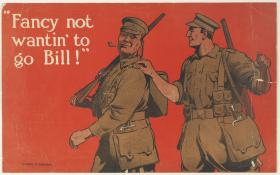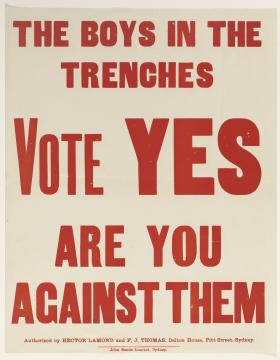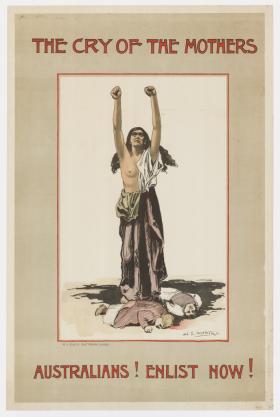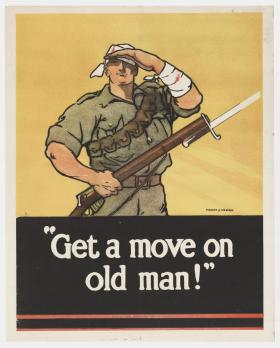WWI: recruitment, conscription, propaganda
Students work closely with graphic materials and newspaper articles from WWI, analysing how recruitment and conscription paraphernalia and news reports reveal the values and attitudes of people at that time.
Learning intention
Students are learning to:
- interrogate sources in order to extract relevant information in response to historical inquiry
- process and synthesise information from primary sources to be used as evidence when making an historical argument
- interpret history within the context of the values and attitudes of people in the context of the past
Success criteria
Students will be successful when they can:
- summarise the approaches used in the creation of recruitment and later conscription paraphernalia for WWI, in reference to surviving evidence
- explain how primary sources reveal the values and attitudes of people at that time in history
Student Activities
Compelling evidence
Students investigate a range of WWI posters to better understand the attitudes and values that drove appeals to enlist to fight in WWI.

Shirkers and Tempters
Studying a number of different posters produced by those in favour of conscription, students investigate the arguments behind this stance and how the referendums were 'fought'.

The Cry of the Mothers
Students investigate the ways in which the 'Yes' and 'No' sides in the argument about conscription appealed specifically to women and the Mother.

All there in black and white
Students consider the role of the media of the day in shaping public perception of conscription.

NSW Syllabus for the Australian Curriculum History K - 10
HT5-1 explains and assesses the historical forces and factors that shaped the modern world and Australia
HT5-2 Sequences and explains the significant patterns of continuity and change in the development of the modern world and Australia
HT5-4 Explains and analyses the causes and effects of event and developments in the modern world and Australia
Impact of the wars on Australia (ACDSEH096, ACDSEH109)
Students:
- Outline the Australian government’s control on the home front in both wars for each of the following:
Conscription - Use of government propaganda
Comprehension: chronology, terms and concepts
- read and understand historical texts
Analysis and use of sources
- identify the origin, content, context and purpose of primary and secondary sources (ACHHS169, ACHHS187)
- process and synthesise information from a range of sources as evidence in an historical argument (ACHHS170, ACHHS188)
Perspectives and interpretations
- identify and analyse the reasons for different perspectives in a particular historical context (ACHHS172, ACHHS173, ACHHS190, ACHHS191)
Empathetic understanding
- interpret history within the context of the actions, values, attitudes and motives of people in the context of the past (ACHHS172, ACHHS173, ACHHS190. ACHHS191)
Cause and effect
Perspectives
Empathetic understanding
Learning across the curriculum
- Critical and Creative thinking
- Information and communication technology capability
- Intercultural understanding
- Literacy
Other
- Difference and diversity
What was the significance of World War I to the home front population?
How did WWI impact on Australian government controls related to conscription, propaganda, wartime controls and censorship?
Background notes for teachers and students
Conscription
During 1916 and 1917, two bitter and divisive referendums were conducted on the issue of conscription at the height of WWI.
Compulsory military service had been part of Australian life before the declaration of war in 1914. Shortly after Federation, the Defence Acts of 1903 and 1904 provided that men between 18 and 60 should be liable for service in time of war, but this legislation also prohibited members of the military forces from serving beyond the limits of the Commonwealth and Commonwealth territories, “unless they voluntarily agree[d] to do so” (Defence Act 1903, s. 49).
As such, at the beginning of WWI Australian troops fighting overseas enlisted voluntarily. In the early stages of the war, voluntary enlistment numbers were so high as to provide more than enough men to support Australian efforts, with recruitment officers forced to turn people away. However, as the enormity of Australian casualties on the Western Front became known in Australia and as no quick end to the war seemed likely, the number of men volunteering fell steadily. Australians began to realize that this war was not going to be a short and glorious affair. By 1916, the Australian Imperial Force (AIF) faced a shortage of men.
Sustained British pressure on the Australian Government to ensure its divisions were not depleted, and recruiting targets not being met, Prime Minister William Hughes reached the conclusion that conscription would be necessary to raise the required number of reinforcements. With conscription strongly opposed by his own party in the senate, Hughes decided to ask the people in a referendum if they would agree to a proposal requiring men undergoing compulsory training to serve overseas.
The issue stimulated bitter and divisive argument within Australian society. The debate featured censorship, propaganda, mass rallies and union strikes. A new battle, this time on the home front, had broken out. In this battle, the government ruthlessly used the machinery of state under the War Precautions Act 1914 to censor debate, seize opposing propaganda and repress opposition. Furthermore, the government brought in a requirement for all single men aged between 18 and 42 to present themselves for military service, even those rejected for service overseas, in 1916.
The referendum was held on 28 October 1916 and resulted in 1 087 557 votes for and 1 160 033 against. Whilst the referendum was defeated, the government stepped up its enlistment drive, with large segments of the media also pushing similar messaging. Newsreels in cinemas showed battleships loaded with cheering soldiers leaving port, scenes of French cafes and mateship in the trenches and an array of posters and advertisements pushed guilt buttons.
The political ramifications of the defeat for conscription for overseas service went to the heart of Parliament. William “Billy’ Hughes, expelled from the Labor party in November 1916, was followed by 23 others to form the United Labor Party. With the support of the then Opposition he formed a new ministry, and in the general elections of 5 May 1917 the new Nationalist Party (a merger of National Labor and the Liberals) was victorious, with Hughes as Prime Minister.
Pressure from Great Britain continued to be exerted on Australia, however, and faced with further declines in voluntary enlistment, Hughes opted for another referendum on conscription in December 1917. This time, a modified proposal was submitted to Australian voters with a plan to conscript for overseas service only enough men to make up a total of 7 000 men a month. The campaign was bitter, and arguments split communities as both sides trotted out their campaigns. Newspapers and magazines of the time demonstrate the concerns, arguments, and passion of Australians in debating this issue.
When the vote came around on 20 December, Australia again voted against conscription, with the ‘no’ vote increasing slightly in most states.
Perhaps most poignantly, conscription for overseas service was rejected by the men in the war zones. Reasons given included ‘nobody should be made to come to this’, ‘every man should be able to make up his own mind’ and ‘if they have to be forced to come they won’t be much good over here’.
The decisive defeat of the second referendum closed the issue of conscription for the remainder of the war.